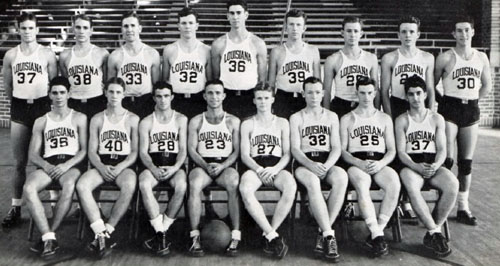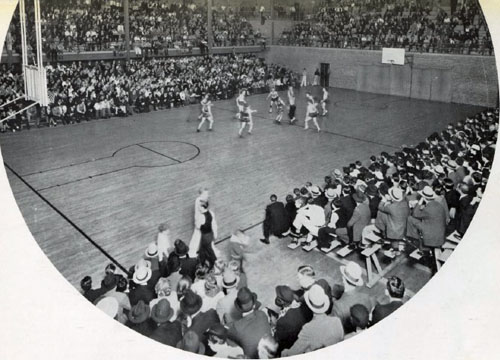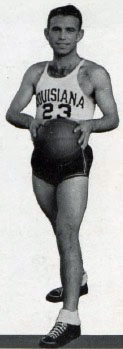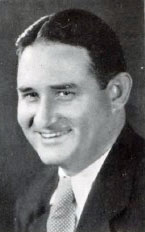LSU Short Story

1935 LSU Tigers

1935 LSU home game in the Huey P. Long Field House
Shawn Fury, LSU Alumni Magazine (Spring 2017)
|
As I researched my 2016 book Rise and Fire: The Origins, Science, and Evolution of the Jump Shot - And How It Transformed Basketball Forever, I discovered an old quote from former Kentucky basketball coach Adolph Rupp, praising LSU star Malcolm "Sparky" Wade. In a 1935 newspaper story, Rupp said, "Louisiana State University, led by the diminutive 'Sparky Wade,' was the colorful team of the year. Spectators came hundreds of miles to see this lad perform. Weighing but 135 pounds, fast as a streak, and using a sensational jump shot, he clowns through the game." I never found more evidence that indicated Wade took jump shots, back when almost no one executed that maneuver. But the player everyone called Sparky was still a legend of his era. Yet because of the time during which Wade played - media coverage was regional and the NCAA title game didn't exist - his exploits are unknown to many. But during the 1930s, few had a bigger impact than one of the smallest men on the court. Wade stood approximately 5 feet, 8 inches tall and hailed from Jena LA, a town that consisted of about 1,000 people during his youth. Multiple theories emerged about the origin of his nickname Sparky. One newspaper speculated it was "for his ability to 'spark' the girls, or the fact that he whisked up and down a basketball court like so many sparks flying." Following an outstanding high school career, Wade first attended LSU but clashed with coach Harry Rabenhorst. Wade then fled his home state for Southern Methodist University in Texas. His time in Dallas didn't last long. No one knew for sure why he returned to Louisiana. One legend? Governor Huey Long called Wade and told him he had thirty-six hours to get back to LSU or he'd bulldoze Jena. Whether the Kingfish's threats played any role or not, once the star came back he turned LSU into a powerhouse. And he did it with flair, delighting fans and frustrating opponents with his behind-the-back passing, sharp vision, and fancy dribbling. He also let everyone know how good he was on the court. A trash talker, Wade would, according to one report, make "very disparaging remarks about [an opponent's] heritage, particularly his mother." He also anonymously called newspapers in opposing cities and told them to check out a sensational player named Sparky Wade. |
|

1935 LSU Tigers
In 1935, Wade led the Tigers to a 14-1 record, 12-0 in the SEC. At the end of the season, LSU defeated Pittsburgh in the American Legion Bowl, and the school claimed a mythical national title, though there was no actual champion crowned. But with Wade, there was no doubt LSU could compete against anyone. Wade, who became an airline pilot, died on Feb. 25, 1983, on his seventy-third birthday.
No films exist of Wade on the court, and in the 1930s basketball hardly made an impression on the national landscape. Yet few Tigers exceeded his legacy. In the words of his old coach, Rabenhorst, "Sure he was cocky, but then he could do anything he said he could. For a little man, he was the greatest."
No films exist of Wade on the court, and in the 1930s basketball hardly made an impression on the national landscape. Yet few Tigers exceeded his legacy. In the words of his old coach, Rabenhorst, "Sure he was cocky, but then he could do anything he said he could. For a little man, he was the greatest."

1935 LSU home game in the Huey P. Long Field House

